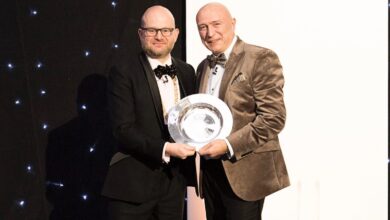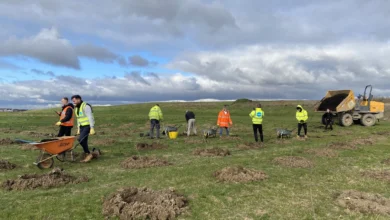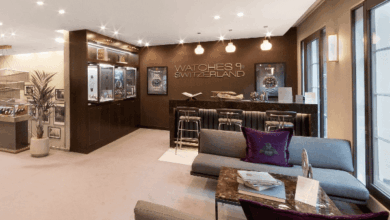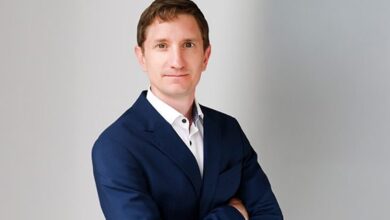Jessica Flinn on changes, challenges and trends in the jewellery industry
The National Association of Jewellers' newest member, Jessica Flinn, talks to us about the state of the jewellery industry today, including the challenges and changes it is having to deal with. With the introduction of her most recent Eras Tour ring collection, which was inspired by each Taylor Swift album, Flinn also emphasises the significance of identifying and adapting new jewellery trends in order to grow your brand.

Register to get 1 free article
Reveal the article below by registering for our email newsletter.
Want unlimited access? View Plans
Already have an account? Sign in
Can you tell me about yourself and the history of Jessica Flinn?
I started Jessica Flinn Designers Limited straight out of university in 2010, so it has been 13 years now, which is absolutely bonkers. I initially started out making stainless steel and silver jewellery, and I would sell it to independent retailers for the first few years of my business. I then opened a shop in Sheffield and went into House of Fraser under concessions. We had around 19 concessions in the House of Fraser, and it was an absolute disaster. So I grew quite rapidly at the beginning, and I really embraced the wholesale world. But it was a terrible period of my life; I lost a lot of money and a lot of jewellery, and so we decided to close it all down.
I then started to run appointments from our home in the Peak District and scaled it all back at that point. That was the beginning of the format we’re in now. I started doing appointments with customers and creating bespoke engagement rings and wedding rings, and then I launched my own collection in 2019 and started developing our online presence. We grew quite rapidly from 2020 to now. We went from a team of three to 21 now. But we established two different companies as well. We started Flinn and Steel, which is our sort of sister brand. But it started underneath Jessica Flinn, and then we separated it out. Flinn and Steel features alternative metals such as stainless steel, tungsten, and titanium. So that’s one side of the business, and we kind of share stuff across the two companies and two websites.
How would you describe the state of the jewellery industry?
That’s a very big question, and to answer it, I broke it down into three parts. Obviously, the economy is not great right now; we’ve been through the pandemic, and now we’re in the cost of living crisis. We’ve seen high increases in the prices of products because of the Russia-Ukraine war, as well as everything else going up, such as rates, rent, and energy costs. So I can only describe the jewellery industry as the wild west right now. It is hard, but we’re thriving under these strange circumstances. However, I do think that in general, there are a lot of jewellery businesses out there that are struggling because they don’t have the disposable income that they used to have. Even customers are much more conscious than they used to be. So I would say it’s tough times, but I think if you can pivot and adapt, then you can survive this period. It’s not all doom and gloom.
Second, the industry has become more eco-conscious and is trying to be better and more sustainable. I think that is great. There have definitely been talks at trade fairs around sustainability, so there are some cogs slowly moving in that direction. It is a very traditional industry, and at the end of the day, it’s going to take a long time for any major change to sweep in. But there are definitely the beginnings of a movement there.
Lastly, I would like to talk about the state of the industry in terms of representation and diversity, which are very important to us. For instance, we recently did a Pride photoshoot where we had all members of the LGBT community as our models. So to sum it all up, there are lots of opportunities, and one of the great things to come out of the pandemic is consumers becoming more aware and conscious of what they’re consuming, which will only lead to positive change. So you know, some good, some bad; it’s a combination of both.
How important is it to identify and adapt to trends in the jewellery industry?
So there are a wide variety of trends that I think companies should follow and some that they should not. As a company, in general, we try not to follow seasonality; we’re not about the summer trends or the winter trends; we try to create a collection that will stand the test of time. So with anything that we produce, we make sure that it isn’t actually transient.
I absolutely love digital PR, and I think, for us, it’s been a big growth opportunity. So I would say that the most important thing is to find out more about your actual customers than the trends. You can obviously look into the trade press, fashion magazines, or watch the Met Gala to educate yourself and know what’s happening in those spheres. But I think the more important thing is to look at your actual customers and find out what they are interested in. What are they passionate about? What are the things that they care about?
Realistically, it’s also about nurturing your own talents. So, Charlotte Owe, who was our CAD designer, came up with the concept for the Taylor Swift rings. In another business, maybe they would just be pushed down. That’s not what we do here. If somebody has a spark, we follow that spark until we find where it’s going, and I think that’s probably more important. So businesses should also focus on nurturing their own talent, look inward, and try not to look outward too much. That’s how you will end up doing something that’s a bit different.
Lab-grown diamonds have very smoothly and rapidly entered the jewellery market. Has its demand increased among customers?
We’ve actually been doing lab-grown diamonds since 2020, so to us, they don’t feel like a new thing. I asked my chief operating officer what we are looking at stats-wise for lab-grown diamonds at the moment, and she was like 80%. So 80% of our customers are choosing lab-grown diamonds. However, we’re not team lab-grown versus team mine. We offer both, and we educate our customers on both. I’m both because I think there’s a lot of like choosing teams in the jewellery industry, and it’s not quite the right thing to do. Because, you know, although De Beers are like the evil geniuses of the diamond world, they also do great things for the communities around the mines. It’s these artisan miners that also rely on the trade, so it’s more complicated than it looks; it’s not black and white. Which is why we’re officially both teams with regards to lab and earth-grown.
But I would say that, like, 80% of our customers are leaning towards the lab now and have a completely open mind about it. I think financially is the main reason why, but also because our consumers are quite conscious; they’re not going to put their money into something that doesn’t align with them. I would say lab-grown diamonds have always been popular, especially in the last few years.
I think there’s always going to be a place for traditional earth-ground diamonds, but there’s also a place for the lab ones too, and it would be great to see if you get more lab supplies that have sustainable energy sources, so we can make things really take off. But the more customers ask for it, the more power we have as retailers to create that change. It’s a ripple effect.
How has AI made its way into the jewellery industry?
I would say we are at the beginning of our AI journey. We at Jessica Flinn are fully embracing tech, and we have tools like design your own ring where customers can customise jewellery on our website, but it’s not AI yet. It’s not like we’re learning about our users as they’re doing it. I’m honestly quite excited about the future of AI. I think there’s just so much potential, and the geek in me loves data. So we could get AI-like software in our stocktake that would narrow everything down and tailor our stock ordering for the next year based on that intelligence. So I do think technology like this would be useful, and we get a lot of inquiries that ask the same sorts of questions. So if AI did develop to a level where it really felt like a human experience, then there’s lots of potential there.
But also, I think it’s about balance. People aren’t going to buy from you if you’re 100% AI because you need people and faces on your social media and website, in your emails, and in your personal responses. So, like, it’s never going to replace our industry, but it might complement a lot of what we do, but it’s definitely never going to replace it because you’re always going to need your designer, and you’re always going to need your person with the experience. You need that relationship for sales and guidance, and we’re a long way off AI being able to do that yet. However, I would definitely embrace it in elements like stock and logistics.
What kind of challenges do jewellery retailers face today?
I think that the biggest hindrance to your traditional jeweller is probably the ageing of their customers. A lot of jewellers rely on their bread-and-butter customers, who come back for regular work on the high streets. However, these traditional jewellery businesses are not what they used to be, and their customers are ageing, and the new generation that is coming in probably isn’t just going to walk off the high street. So I think a big challenge is modernising the way traditional jewellers think about their customers.
Another big challenge is probably that the councils in every area do not support the high streets. Business rates and rent are crazy, and if the rents were brought down to a reasonable level, things could be healthy. We’ve got a lot of problems, particularly in Sheffield, with them wanting pedestrianised areas, but there’s no parking for customers. So they’re basically creating these awful environments for traditional shops to be in.
Additionally, I think there’s a change in what customers actually want to experience when they come into a shop, and it’s not necessarily your traditional experience anymore. It’s a different way of being; they want something different, and they want to feel like they’re immersed in an experience. Amazing customer service definitely gives you that, but that’s almost not enough now. And it needs to be done in a different way.
What big changes have you seen since you first entered the jewellery market and now? And what changes do you anticipate?
I think because it’s a very traditional industry, changes happen very slowly. When I first started, it was all about the trade shows, and then they died off. Now they’re trying to make a resurgence, but I just think people don’t do things that way anymore. I’m definitely seeing a movement towards more conscious suppliers and more demand from customers. There are some amazing small independents out there that are really trying to do ethically sourced things, which is great. There must also be more online retailers now that don’t even have traditional retail branches, and that wouldn’t have been a thing when I first started because you couldn’t just have a website. Now there are people who solely run e-commerce businesses.
I also think the way that we advertise and the way we reach new customers have changed. In the beginning, I would probably do advertising and trade press or like local magazines or sponsor events, but nowadays, it’s all digital advertising for us, where we are exploring YouTube shots, Google advertising, Tik Tok, Facebook, and Instagram. Digital PR is going to be really important, and it’s just something that I don’t see traditional retailers doing yet, apart from the big brands.
Where does Jessica Flinn envision itself in five years?
We’re going to relocate out of our head office in about two and a half years, and we would like to expand our head office offering. We’re also going to bring manufacturing back to us. We are also planning to open a Manchester branch. Now, when I say branches, I don’t mean traditional retail; I don’t mean a High Street store, because that would not be us. But we definitely want to open another location. I think we’ll probably expand with regards to our digital advertising by increasing our advertising on different platforms and different places and just trying to grow like an E-commerce site that way as well. Obviously, we’re always bringing in new products, new product lines, and new gemstones. We may also incorporate a home-trying service. In short, we’ll probably be completely different in five years’ time because we’re completely different than six months ago or even a year ago. So five years just feels like a huge amount of time.







